Patent Office
by Elton Gish
Reprinted from "Crown Jewels of the Wire", March 1995, page 4
CD 178.5
NEW FRED M. LOCKE GLASS INSULATOR
During the research for my new book, Fred M. Locke: A Biography, I found an
article in the May 29, 1915 issue of Electrical World advertising glass pin-type
insulators which were made using Fred Locke’s glass patents. Amazingly one of
his granddaughters had the original photograph which appeared in that trade
journal article, and a second photograph on the same sheet showed another glass
pin-type insulator. Neither of the two glass pin-type insulators have been
reported by collectors until now. George Webster (NIA #581) just reported that
he has one of the two glass insulators shown in the original photograph and in
the trade journal article! He found it at a local antique shop in about 1980.
Before you get too excited with thoughts of checking out the neighborhood for
another one of these rare jewels, you must realize that George is from Puunene,
Hawaii! That is a long way from the insulator’s birthplace in New York. Wow,
if this jewel could talk maybe we could track down another one. George’s nice
sketch gives you the details of this unusual insulator. N. R. (Woody) Woodward,
originator of the Consolidated Design numbering system, has assigned CD 178.5 to
George’s insulator.
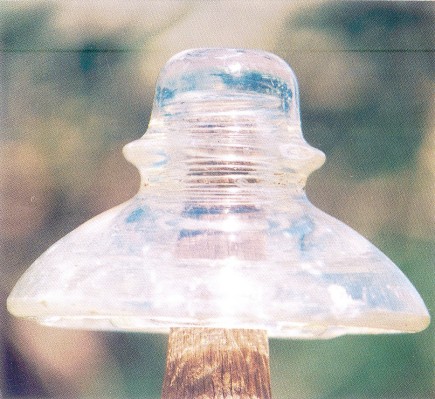
The color of George’s CD 178.5 is “light yellow opalescent” with a “slight
milkiness”. (See front cover of this issue, above.) Embossed upside-down around the
top skirt is the following marking:
|
Front: |
MAR. 31,1914 F. M. LOCKE
VICTOR
N.Y.
|
Back: |
PAT. FEB 2, 1915 |
An insulator with this patent date marking is not entirely unique. In the
December 1989 issue of Crown Jewels of the Wire, I reported three CD 241
insulators that have the following upside-down marking:
|
Front: |
PATD BY F. M. LOCKE
VICTOR
N.Y.
|
Back: |
MARCH 31 1914 FEB 2, 1915
OCT. 12, 1915
|
Three CD 241’s are known with the above marking. The colors are very pale
lemon yellow and pale greenish aqua. None of the CD 241’s have opalescence or
milkiness. George’s CD 178.5 was obviously made before the CD 241’s which
have the additional October 12, 1915 patent date.
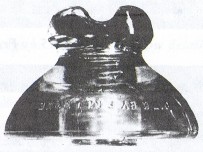
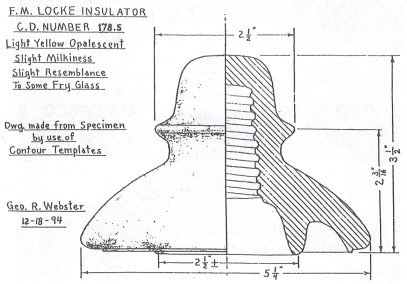
Unknown Fred Locke insulator
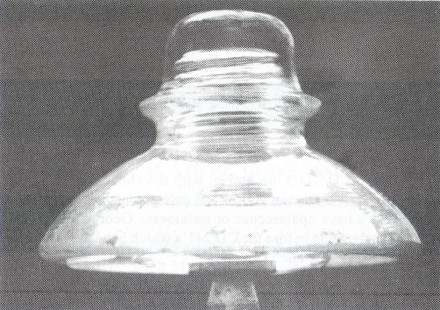
CD 178.5 by Fred Locke
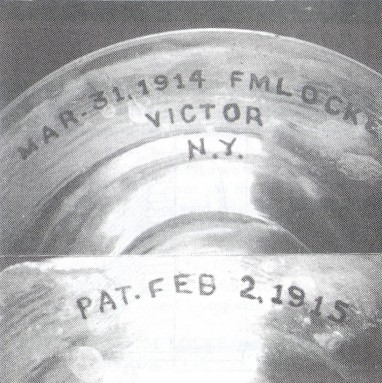
Upside-down markings on CD 178.5
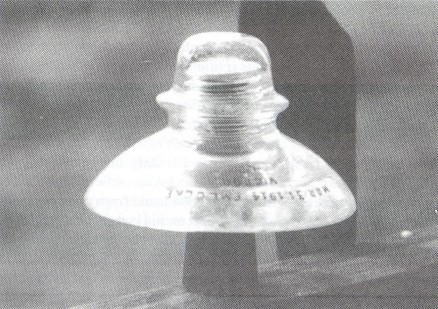
Paint was applied to markings on CD 178.5 to show detail.
Since Fred Locke was “The Father of Porcelain Insulators”, most of you
are probably wondering why he obtained patents for glass formulas and produced
glass insulators. Most of the answers are in Chapter 12 of my new book, and
there is no way that the information and photographs shown on those 20 pages can
be duplicated here. Detailed discussion of Fred Locke’s glass patents, their
use by the Fry Glass Co. and Corning, and all the many styles of glass
insulators he marketed, is too complicated to reproduce here, but I will attempt
to briefly describe what the patents concerned, who made the glass insulators
for Fred Locke, and discuss the latest research into an interesting part of his
life many years after his involvement in porcelain insulators.
After Fred Locke “retired” from the Locke Insulator Mfg. Co. in December
1904, he continued to work for them as a consultant (after the law suit against
him was settled). He purchased a large home in Victor in 1900 and added a large
laboratory on one side after he “retired”. There he experimented with ways
to improve the quality of the insulator material used for porcelain insulators.
Several patent applications were filed in 1905-1909 for improvements in
porcelain formulas. Probably quite by accident he developed a formula that was
actually a new form of glass. Glass is not that much different in composition
than porcelain. In the June 24, 1909 issue of Electrical World, Fred Locke
announced his new insulating material calling it “Transparent Porcelain”.
The article stated that The base [of the new material] is aluminum silicate
[feldspar], and the material can be melted and cast in the same manner as glass.
Two of the remarkable features are the temperature changes it will withstand,
and its high specific inductive capacity. These, together with great mechanical
strength and high resistivity, ideally fit the material for all classes of
insulation.” Only one specimen, the middle skirt from an insulator similar to
Brookfield No. 331, is known that is credited with having been made from this
material.
Fred Locke was not one to rest on his laurels. He continued to improve the
new insulating material. Several more patents were granted for other glass
formulas from 1908-1922 which totaled 15 patents in all. Most of the glasses
were borosilicate types similar to Coming’s Pyrex glass for which a patent was
granted them on May 27, 1919 on an application originally filed June 24, 1915,
later divided and re-filed on Sept. 16, 1916. As stated in Fred Locke’s
patents, some of the formulas produced an opalescent glass and others were clear
or tinted. There are articles in trade journals from 1915 to 1916 which refer to
the glass as “Boro-porcelain” and “Boro-silicon”. At first Fred Locke
appeared to deny the fact that he had discovered a new glass formula by calling
it “Transparent Porcelain” and “Boro-porcelain”. The new glass formula
was superior to porcelain with regard to temperature resistance. The glass
expanded very little when subjected to heat making it less susceptible to
breakage from large temperature changes. The two patent dates shown on CD 241
and CD 178.5, March 31, 1914 and Feb. 2, 1915, each represent two patents
granted on those dates.
Fred Locke was having glass insulating tubes, pin-type insulators, and modem
styles of suspension insulators made by the Corning Glass Works (see the various
photos in my book). Direct evidence of this was uncovered after my book was
published. Coming announced their new glass baking ware and other dishes in
Boston in the third week of May 1915. Fred Locke probably received his first
order of insulators from Coming earlier that same year. Fred Locke’s letter to
Corning dated May 22, 1915 said, “I should like very much to have a selling
agency for your new heat resisting, cooking and other dishes, as I believe the
dishes handled together with the insulators will help to advertise them both ...
you may send me by express a full set of these dishes for my own family use, an
extra set that I may send out as samples.“ The use of Fred Locke’s patents
on his insulators is puzzling in the light of an April 5, 1916 letter he sent to
Corning where he said “...please make me 1 000 #8 insulators from tank glass G
702-EJ”. We do not know what the “G” stood for, but “702-EJ” was
Corning’s basic Pyrex ovenware-labware formula which went unchanged until the
early 1980’s.
Corning started making trial melts of various Fred Locke glass compositions
on July 1914. In these trial melts, samples of insulators were produced and sent
to him. One of the trial melts in early 1915 was very close to Corning’s Pyrex
glass formula and the sample insulators were not sent to him. On July 22, 1916,
Corning sent notice to Fred Locke that they would not make any more insulators
for him. Evidently, legal questions arose concerning Corning’s patent
application for Pyrex glass and Fred Locke’s similar glass formulas; however,
I suspect that Corning was thinking of getting into the insulator market. Fred
Locke was shut off abruptly without any way to fill orders for his insulators
and he appeared quite desperate in a letter to Corning’s Vice-President. He
expressed that demand for his insulator was developing and his reputation would
be damaged if they continued to refuse his orders.
Probably just as well that Fred Locke lost the manufacturer of his insulators
since the practicality of his suspension insulators was not without question. A
letter from an engineer in Italy dated July 1, 1916 stated, “ ..the mechanical
resistance is too little; the breakage took place in the trials we made were not
due to lack of cement, or length of bolt, but to the material itself, in the
thickness between the cap and the bolt.” Their power lines experienced heavy
weights of ice making it necessary for them to specify suspension insulators
that would withstand a strain of 11,000 lbs. which Fred Locke’s insulators
would not tolerate. The letter said that if he could redesign the insulators so
they would pass testing, then a purchase order would be sent for 6,000
insulators to re-insulate one of their lines.
After Corning refused to make any more insulators for him, Fred Locke became
convinced that Corning was trying to steal his glass formulas. On February 13,
1917, Corning offered a contract to Fred Locke that would give them the right to
make glass insulators from his borosilicate glass and a small annual royalty was
proposed. Fred Locke sent his proposed contract to Corning on February 17, 1917
asking for a much larger royalty payment. One Corning letter from February 27,
1917, stated that, “...in conversation with Frank Brookfield, of the
Brookfield Glass Company last week, I was told that they have some sort of an
agreement with Locke which gives them rights in the matter of borosilicate
insulators. I met Brookfield, who was a classmate of mine, at a Class Dinner,
and he said that he would be glad to give me full particulars when I am next in
New York.” Further negotiations were held with Fred Locke in early March 1917
to no avail. A letter detailing those negotiations said, “I am convinced that
he firmly believes we have stolen certain inventions from him, and in return he
has done his best to steal from us; working, apparently on the Prussian
principle that one wrong justifies another.”
Fred Locke went on the attack with a patent application filed on August 16,
1917, that was in direct conflict with Corning’s Pyrex patent application. The
situation quickly led to Fred Locke filing a suit against Corning in October
1917. I suspect a settlement was reached. The Fry Glass Co. also got involved
with Fred Locke’s difficulties. That situation, and an interesting legal
arrangement between the Fry Glass Co., Fred Locke, and Corning, is detailed in
my book. The rights to a 1925 Fred Locke glass patent (more important than
Pyrex) was purchased by Corning and a form of it is being used by NASA and may
even be in your kitchen. The final chapter to this story was at last confirmed
by a Corning document which indicated that the rights to Fred Locke’s patents
were purchased in 1931 for $72,000 — a year after Fred Locke died.

Recreation of Locke letterhead used in 1916.
Actual letterhead would have been too small when reduced to fit page.
|
